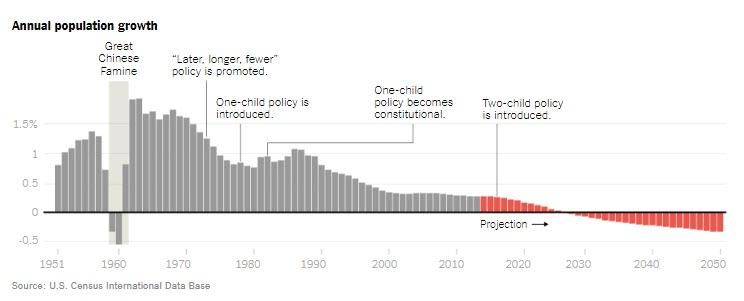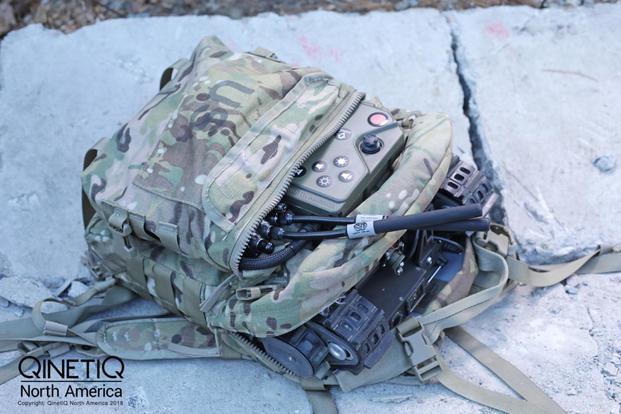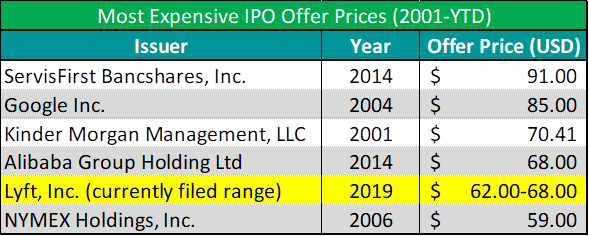Submitted by Nicholas Colas of DataTrek Research
Guess which country’s preeminent social sciences think tank wrote in a recent report: “The era of negative population growth is coming soon”. That “soon” is a tell, because this is not from researchers in Japan, Italy, Portugal or Greece. All those countries already show negative population growth.
The country in question is China. Using expected future fertility rates from the United Nations (which must comport with their own analysis, or they would have used their own numbers), the Chinese Academy of Social Sciences reported that:
-
The Chinese population will peak at 1.442 billion people a decade from now in 2029.
-
From 2030 on, the population base will shrink by 0.3% annually until 2050, at which point it will be 1.364 billion.
-
The trend to a smaller Chinese population will extend to at least 2065, at which point the country will be back to levels last seen in 1996 (1.248 billion).
-
All this assumes fertility rates increase from the current 1.6 children per woman to 1.77 by the end of the forecast horizon. The researchers note that if fertility rates remain constant, China’s population will decrease to 1.172 billion people by 2065, the same as it was in 1990.
-
Link to the report at the end of this section. Google Translate works well here.
All this stands in stark contrast to United Nations projections for many regions of the world (2000 – 2050):
-
Asia as a whole: +0.7% per annum
-
Africa: +2.3%
-
South/Central America/Caribbean: +0.8%
-
North America: +0.7%
-
Oceana: +1.2%
-
Only Europe is expected to show population declines on a regional basis, at -0.3%.
China’s “one child” policy, which ran from 1979 – 2015, is one cause of the country’s current demographic challenge. After it was changed to a “two child policy” in 2016, fertility rates did pick up for a year but declined again in 2017 and 2018. Demographers use 2.1 children/woman as a “replacement rate” for the existing population. In 2018, China’s fertility rate was 1.6 children/woman, below the Chinese Academy’s worst-case long-term scenario mentioned above.
Now, you’re no doubt aware of the demographic challenges facing the other countries we mentioned at the top of this section, and how those inform macroeconomic policy and long run growth potential. Japan and much of Europe are already shrinking, a significant issue for policymakers from local officials all the way to the European Central Bank. Add to that an associated increase in median age of the population, and you get a gale of headwinds that are hard to redress.
What’s also interesting to us about the Chinese data: compare the expected median age of the population there in 2050 (30 years from now) to some of the countries/regions we know already face the issue of a shrinking and aging base of citizens:
-
Japan: 48.6 years median age of the population today
-
Europe: 42.7 median age today
-
China’s current median age: 35.6 years
-
China’s median age in 2030: 41.1 years (close to Europe today)
-
China’s median age in 2050: 45.2 years (close to Japan today)
-
Worth noting: North America’s median age is currently 37.5 years, 5% older than China’s current reading. By 2050 projections have it at 42.1 years, 7% younger than China’s population.
The upshot to all this in 3 summary points:
#1: Demography is not destiny, but it is always a factor to consider when assessing a country/region’s long-term growth rates. Recent economic history in Europe and Japan shows that when population growth goes negative and median age rises, a host of economic and political stresses come to the fore.
#2: A country’s potential GDP growth is a function of population and productivity growth, and nothing else. Chinese policy makers know that the impending decline of the local population must come with significant advances in productivity to assure future growth. While the country has scaled back on its “Made in China 2025” rhetoric, it must continue to invest in disruptive technology to enable future productivity gains. Population growth will soon be an outright negative to the GDP equation.
#3: Unlike China, Japan and Europe, US population growth should remain positive through 2050 and beyond. The US Census Bureau does have a slow decline in percentage terms in their numbers, from 0.70%/year now to 0.40%/year in the out years. That may not seem like much, but it is a notable difference when other major economic centers around the world will be shrinking. Score one more point for favoring US equities, our current (and long-standing) investment position.
Sources:
Chinese Academy of Social Sciences report: http://ex.cssn.cn/zx/bwyc/201901/t20190104_4806519_1.shtml
A New York Times article published just after the report was issued, with more information: https://www.nytimes.com/interactive/2019/01/17/world/asia/china-population-crisis.html
Median Age Projections: https://www.eea.europa.eu/data-and-maps/figures/median-age-projections
via ZeroHedge News https://ift.tt/2CqIora Tyler Durden













